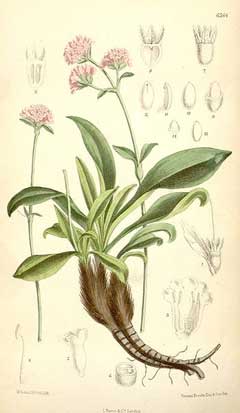 |
|
http://commons.wikimedia.org/wiki/File:Nardostachys_grandiflora.jpg |
 |
|
Translate this page:
Summary
Physical Characteristics

 Nardostachys grandiflora is a PERENNIAL growing to 0.3 m (1ft) by 0.3 m (1ft in). It is in flower from August to September. The species is hermaphrodite (has both male and female organs).
Nardostachys grandiflora is a PERENNIAL growing to 0.3 m (1ft) by 0.3 m (1ft in). It is in flower from August to September. The species is hermaphrodite (has both male and female organs).
Suitable for: light (sandy), medium (loamy) and heavy (clay) soils. Suitable pH: mildly acid, neutral and basic (mildly alkaline) soils. It can grow in semi-shade (light woodland) or no shade. It prefers moist soil.
UK Hardiness Map
US Hardiness Map
Synonyms
N. jatamansii. DC.
Plant Habitats
Woodland Garden Sunny Edge; Cultivated Beds;
Edible Uses
Edible Parts:
Edible Uses: Condiment
Used as a condiment[177]. No more details are given.
References More on Edible Uses
Medicinal Uses
Plants For A Future can not take any responsibility for any adverse effects from the use of plants. Always seek advice from a professional before using a plant medicinally.
Antispasmodic Carminative Deobstruent Deodorant Diuretic Emmenagogue Epilepsy Laxative
Nervine Sedative Stimulant Stomachic
The root is antispasmodic, carminative, deobstruent, deodorant, diuretic, emmenagogue, laxative, nervine, sedative, stimulant and stomachic[46, 61, 178, 218]. It is an excellent substitute for valerian, Valeriana officinalis, and is taken internally in the treatment of epilepsy, hysteria and convulsive affections, nervous indigestion, insomnia, depression and tension headaches[51, 238, 240]. Externally, it is used as a deodorant and to treat rashes[238]. A paste of the root is used externally to treat haemorrhoids[272]. The root is harvested in the autumn and dried for later use[238]. Use this remedy with caution, overdoses are toxic[218].
References More on Medicinal Uses
The Bookshop: Edible Plant Books
Our Latest books on Perennial Plants For Food Forests and Permaculture Gardens in paperback or digital formats.

Edible Tropical Plants
Food Forest Plants for Hotter Conditions: 250+ Plants For Tropical Food Forests & Permaculture Gardens.
More

Edible Temperate Plants
Plants for Your Food Forest: 500 Plants for Temperate Food Forests & Permaculture Gardens.
More

More Books
PFAF have eight books available in paperback and digital formats. Browse the shop for more information.
Shop Now
Other Uses
Deodorant Essential Hair Incense
An essential oil is obtained from the root and young stems. It is harvested before the leaves unfurl[123]. It is used in perfumery[238] and as a hair tonic where it is said to make the hair grow faster and also to turn it black[46, 51, 61]. The dried leaves are used as an incense[272].
Special Uses
Scented Plants
References More on Other Uses
Cultivation details
Succeeds in any moderately fertile moisture-retentive soil in full sun or light shade, especially from the midday sun[200, 238]. Dislikes growing in rich soils[238]. Plants are hardy to at least -15°c[238]. The hairy portion of the stem, just above the roots, has a strong aroma somewhat like patchouli[245]. The fresh root is fragrant, but the scent becomes more pronounced as the root dries[245]. This plant is the spikenard of the Ancients, it was once very popular as a perfume[1].
References Carbon Farming Information and Carbon Sequestration Information
Temperature Converter
Type a value in the Celsius field to convert the value to Fahrenheit:
Fahrenheit:
The PFAF Bookshop
Plants For A Future have a number of books available in paperback and digital form. Book titles include Edible Plants, Edible Perennials, Edible Trees,Edible Shrubs, Woodland Gardening, and Temperate Food Forest Plants. Our new book is Food Forest Plants For Hotter Conditions (Tropical and Sub-Tropical).
Shop Now
Plant Propagation
Seed - best sown in a cold frame as soon as it is ripe[238]. The seed requires light for germination[238]. Prick out the seedlings into individual pots when they are large enough to handle and grow them on in the greenhouse for their first winter. Plant out in late spring or early summer. Division in spring.
Other Names
If available other names are mentioned here
Native Range
TEMPERATE ASIA: China (Gansu Sheng (southeast), Qinghai Sheng (south), Sichuan Sheng (west), Xizang Zizhiqu, Yunnan Sheng (north)) TROPICAL ASIA: Bhutan, India (Sikkim, Uttar Pradesh), Nepal
Weed Potential
Right plant wrong place. We are currently updating this section.
Please note that a plant may be invasive in one area but may not in your area so it's worth checking.
Conservation Status
IUCN Red List of Threatened Plants Status :

Growth: S = slow M = medium F = fast. Soil: L = light (sandy) M = medium H = heavy (clay). pH: A = acid N = neutral B = basic (alkaline). Shade: F = full shade S = semi-shade N = no shade. Moisture: D = dry M = Moist We = wet Wa = water.
Now available:
Food Forest Plants for Mediterranean Conditions
350+ Perennial Plants For Mediterranean and Drier Food Forests and Permaculture Gardens.
[Paperback and eBook]
This is the third in Plants For A Future's series of plant guides for food forests tailored to
specific climate zones. Following volumes on temperate and tropical ecosystems, this book focuses
on species suited to Mediterranean conditions—regions with hot, dry summers and cool, wet winters,
often facing the added challenge of climate change.
Read More
Expert comment
Author
DC.
Botanical References
51200
Links / References
For a list of references used on this page please go here
Readers comment